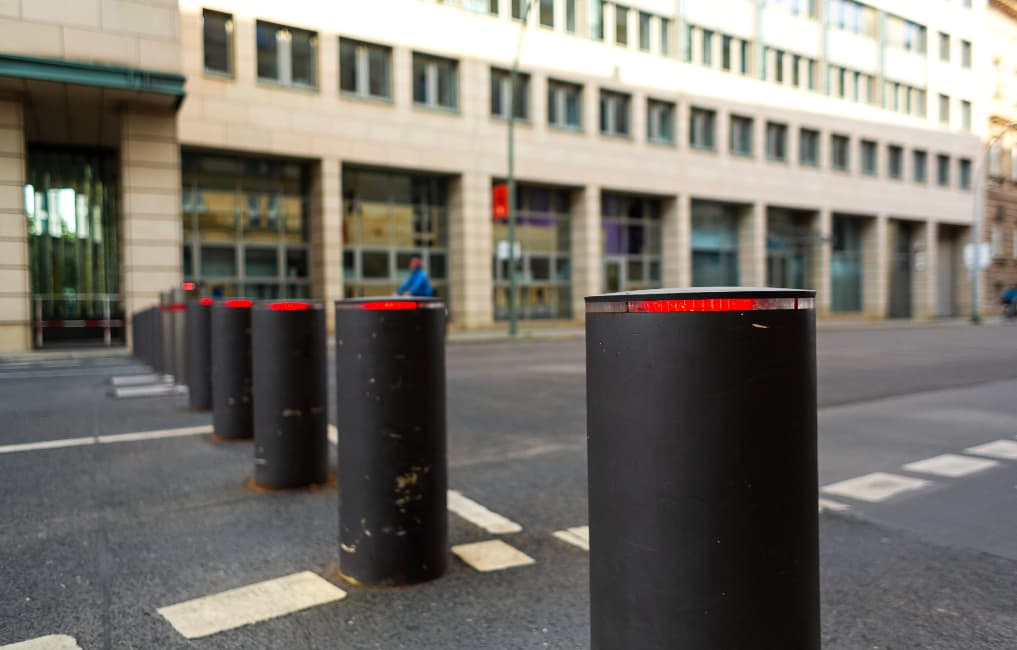Large Stock Available
Domestic & Commercial
Installation Within 10 Days
Quality
Of Work
Parking Security
Price Match Guarantee
Here’s what you need to know about UK bollard regulations

Bollards are immensely useful assets for a wide range of commercial environments and controlled facilities, from supermarket car parks to administrative complexes and other sensitive areas. Accordingly, bollards are governed by a complex framework of rules, which set the basis for a range of requirements – from height restrictions to impact resistance. The exact regulations that are relevant in each case tend to vary depending on the location, purpose, and public access situation.
You may not be familiar with all of these regulations and requirements right off the bat (very few people are!), so if you’re planning on buying automatic bollards or other types of bollard to use as part of a wider safety or security strategy for your site, it’s worth quickly refreshing yourself on some of the most crucial rules. We go into them in a little more detail below!
What do UK bollard regulations cover?
UK regulations for bollards cover a broad range of factors relating to their design, placement, and performance.
At the most basic level, the law sets out how tall a bollard should be (typically between 900mm and 1200mm depending on its function), what materials are suitable, and how visible they must be in different lighting conditions. Highways bollards, for example, need reflective elements and may fall under the remit of the Traffic Signs Regulations and General Directions (TSRGD). In settings where bollards are used for car access control (for example, to prevent ram-raids or terrorism) they must comply with security standards like PAS 68 or PAS 170.
Other regulations also apply depending on the setting. Pedestrian zones must provide sufficient clearance between posts for wheelchairs, prams, and mobility scooters – usually at least 1.2 metres. In car parks and near entrances, bollards must not obstruct sightlines or present a hazard. Electrically operated bollards come with further requirements tied to electrical safety and fault-tolerant design.
The most crucial regulations to know
There’s a number of national regulations, standards, and legal requirements that are essential reading for anyone specifying or installing bollards in the UK. These documents outline the minimum safety, visibility, spacing, and impact-resistance requirements for bollards in public and private settings:
- Traffic Signs Regulations and General Directions (TSRGD). This sets out how bollards used as traffic control devices must be designed and marked. It includes rules on height, colour, reflectivity, and placement on the public highway.
- Manual for Streets (MfS). Published by the Department for Transport, this document provides practical guidance on bollard use in urban and shared spaces, with a focus on accessibility and pedestrian flow.
- BS EN 12767. This British Standard explains how bollards and other street furniture should respond when hit by a car. It sets clear performance expectations for energy absorption and breakaway response.
- BS EN 8442. This standard covers non-illuminated traffic bollards for use in pedestrian zones, shopping centres, and car parks. It defines minimum requirements for strength, shape, and materials.
- PAS 68 and PAS 170. These are key documents for bollards used in security settings. PAS 68 applies to high-risk areas and sets out the performance tests against full-speed car impacts. PAS 170 covers lighter-duty situations with lower threat levels.
- Equality Act 2010. Although not specific to bollards, this legislation affects how you plan their placement. It supports barrier-free access for wheelchair users and people with limited vision. You’ll need to follow it to meet your legal obligations on accessibility.
It’s a good idea to get familiar with these documents, as it can help ensure that you’re installing your bollards within the remit of the law, and that they’ll give you a long operational service life.
Who needs to know the regulations?
Responsibility for knowing and applying the correct regulations falls on several parties, depending on the context of installation and ownership.
Local councils and highways authorities need to follow strict national and local guidance when installing bollards in the public realm. This includes everything from visibility regulations to specific placement requirements under the Manual for Streets.
Private developers and property owners also need to be aware of the rules, particularly where bollards affect public access or intersect with highway boundaries. If a bollard causes an obstruction or restricts accessibility, the installer could face legal consequences or be required to remove it at their own expense.
Finally, facilities managers, architects, and construction contractors also have a role in ensuring compliance.
Who sets the standards and enforces compliance
In the UK, bollard regulations are shaped and enforced by a combination of national bodies, local authorities, and advisory organisations.
The Department for Transport (DfT) is the primary source of national road and street furniture standards, including the TSRGD and related design guidance. These documents set out legal obligations for features such as signage, visibility, and positioning in the public highway.
British Standards (BSI) publish widely recognised specifications like BS EN 12767 for passive safety (breakaway characteristics), BS 8442 for bollards in traffic applications, and the aforementioned PAS standards for security bollards.
Local planning departments enforce rules on installations that affect the streetscape or public access. They have the authority to approve, condition, or refuse applications involving bollards. In conservation areas or near heritage assets, additional design scrutiny applies.
In areas with specific security risks, such as government buildings or crowded places, police counter-terror advisers or Centre for the Protection of National Infrastructure (CPNI) representatives may influence the choice and placement of bollards, particularly HVM-rated options.
Why planning permission might be required
Not all bollard installations require planning permission, but there are several scenarios in which it may well be required. These include:
- Conservation areas and listed buildings. Installing bollards in historically sensitive areas may affect the character of the setting, triggering the need for planning consent or listed building approval.
- Change of use or boundary works. If bollards are part of a broader project that alters how a space is used – such as creating a private car park or a pedestrianised zone – they’ll normally need planning input.
- Obstruction of public highways. Any installation affecting footpaths, roads, or public rights of way requires prior consent from the highway authority.
- Permanent fixtures near road junctions or crossings. Bollards close to car access points may impact visibility splays and require assessment under planning law.
It’s really important to make sure that you don’t risk breaching planning permission rules, or enforcement action can potentially follow – ranging from fines to mandatory removal. In some cases, planning departments also impose design conditions or require bollards to match local architectural styles, so if you feel those might be relevant to your project, you’ll need to ensure you take these into account too.
And of course, if you ever need any help or advice, that’s exactly where we can help here at Bollard Security. We have more than 15 years of experience in installing and maintaining security solutions across the UK for domestic, commercial, and industrial sectors, and we pride ourselves on delivering industry-leading car park barriers, precision-engineered traffic control solutions, and certified hostile vehicle mitigation systems that protect people, property, and public spaces. From commercial premises to high-security environments, our tailored installations ensure maximum safety without compromising on style. Don’t hesitate to contact us on 01535 920362 for advice and recommendations on the best Hydraulic Automatic Bollards or Telescopic Bollards for you!


